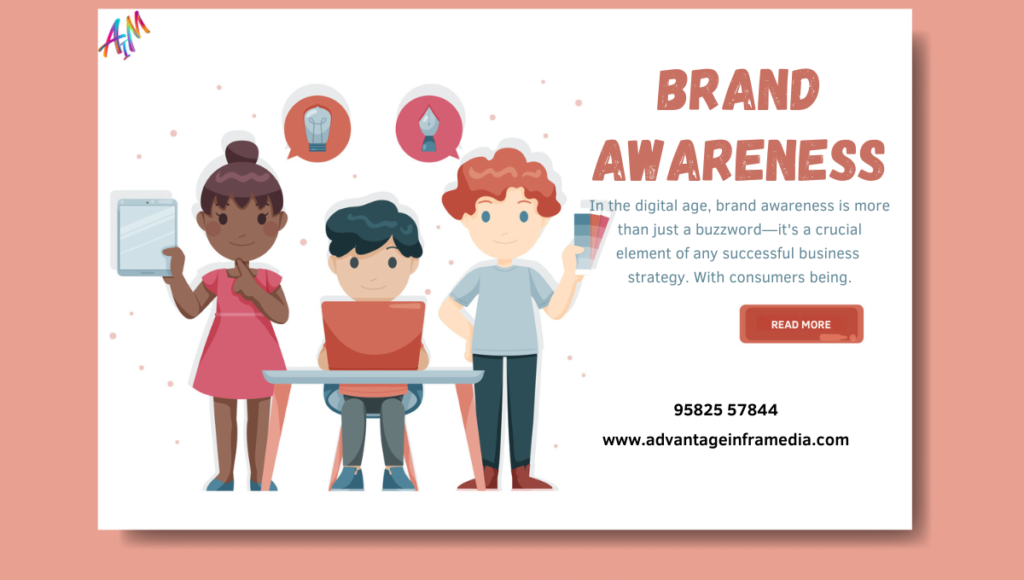Introduction
In the digital age, brand awareness is more than just a buzzword—it’s a crucial element of any successful business strategy. With consumers being bombarded by information from all directions, standing out in the crowded marketplace has never been more challenging. However, one of the most effective ways to achieve this is through leveraging the power of social media. Social media platforms offer unprecedented opportunities for brands to connect with their audience, foster relationships, and build a memorable presence.
In this comprehensive guide, we’ll explore everything you need to know about increasing brand awareness on social media. From understanding what brand awareness is and why it’s important, to developing a robust strategy and creating engaging content, we’ll cover it all. We’ll also dive into the role of paid advertising, the importance of audience engagement, and how to measure and analyze your efforts. By the end of this blog, you’ll have a clear roadmap to elevate your brand’s visibility and connect more deeply with your audience on social media.
Understanding Brand Awareness
What is Brand Awareness?
Brand awareness refers to the extent to which consumers are familiar with the distinctive qualities or image of a particular brand of goods or services. It’s about making sure that your brand is recognized by potential customers and that they associate it with a positive experience. Brand awareness goes beyond mere recognition—it’s about embedding your brand into the minds of your audience, so it becomes their first choice when they need a product or service you offer.
In a world saturated with products and services, brand awareness acts as a differentiator that can set you apart from your competitors. It’s the reason why consumers choose Coca-Cola over a generic cola, or Nike over an unknown shoe brand. High brand awareness means that consumers can identify your brand in a crowded market and are more likely to choose your product over others.
Why is Brand Awareness Important?
- Trust and Loyalty: High brand awareness builds trust and loyalty. When consumers recognize and recall your brand, they’re more likely to purchase from you repeatedly, fostering customer loyalty.
- Market Differentiation: It helps differentiate your brand from competitors. A strong brand presence ensures that consumers think of your brand first, giving you a competitive edge.
- Influence Consumer Decisions: A well-known brand has a better chance of influencing consumer decisions. When consumers are aware of your brand, they’re more likely to consider and eventually choose your products or services.
- Facilitate Marketing Efforts: It amplifies your marketing efforts. Strong brand awareness can make other marketing strategies more effective, as consumers are more receptive to messages from familiar brands.
- Boosts Business Growth: Ultimately, high brand awareness drives business growth. It leads to increased sales, higher customer retention rates, and an expanded market share.
The Role of Social Media in Building Brand Awareness
The Evolution of Social Media
Social media has come a long way since the early days of MySpace and Friendster. Today, platforms like Facebook, Instagram, Twitter, and LinkedIn dominate the digital landscape, each offering unique opportunities for brands to connect with their audience. These platforms have transformed the way businesses communicate with consumers, turning marketing from a one-way broadcast into a two-way conversation.
Why Social Media is Key to Brand Awareness
- Global Reach: Social media allows brands to reach a global audience without the geographical limitations of traditional marketing channels.
- Real-Time Interaction: It offers real-time interaction, enabling brands to engage with their audience instantly and build a more personal connection.
- Diverse Platforms: Different platforms cater to different audiences and content types, allowing brands to tailor their strategies to best fit their target demographic.
- User-Generated Content: Social media is a hub for user-generated content, providing organic opportunities for brands to increase their visibility.
- Cost-Effective Marketing: Compared to traditional advertising, social media offers a cost-effective way to promote products and services and build brand awareness.
Social Media Platforms Overview
- Facebook: With over 2.9 billion monthly active users, Facebook is a powerhouse for brand awareness. It offers diverse content formats, from posts and stories to live videos and groups.
- Instagram: Known for its visual appeal, Instagram is ideal for brands looking to showcase their products and build a lifestyle around their brand.
- Twitter: Great for real-time updates and engaging with followers through tweets, retweets, and hashtags.
- LinkedIn: The go-to platform for B2B marketing and professional networking. It’s perfect for establishing thought leadership and connecting with industry professionals.
- TikTok: Rapidly growing, especially among younger audiences, TikTok is excellent for viral content and short-form videos.
- Pinterest: A visual discovery and bookmarking platform, Pinterest is ideal for brands in niches like fashion, food, and home decor.
Developing a Social Media Brand Awareness Strategy
Setting Clear Goals and Objectives
Before diving into content creation and engagement, it’s crucial to set clear goals and objectives for your social media strategy. These goals should align with your overall business objectives and be specific, measurable, achievable, relevant, and time-bound (SMART).
Examples of brand awareness goals might include:
- Increasing your follower count by a certain percentage over a specific period.
- Boosting engagement rates on your posts.
- Expanding your reach to a broader audience.
- Driving more traffic to your website from social media channels.
Identifying Your Target Audience
Understanding your target audience is the foundation of any successful social media strategy. Conducting thorough audience research helps you identify who your potential customers are, what they care about, and where they spend their time online.
- Creating Buyer Personas: Develop detailed profiles of your ideal customers, including demographics, interests, behaviors, and pain points.
- Audience Segmentation: Divide your audience into segments based on specific criteria (age, location, interests) to tailor your messaging and content more effectively.
- Platform Preferences: Analyze which social media platforms your audience prefers and how they engage with content on each platform.
Choosing the Right Platforms
Not all social media platforms are created equal, and not every platform will be suitable for your brand. It’s important to choose the platforms that best align with your audience and business goals.
- Facebook: Best for broad reach and diverse content types.
- Instagram: Ideal for visually-driven brands and younger audiences.
- Twitter: Great for timely updates and customer interaction.
- LinkedIn: Essential for B2B marketing and professional services.
- TikTok: Perfect for engaging younger audiences with creative video content.
- Pinterest: Excellent for brands with strong visual content and niche markets.
Creating Engaging Content for Social Media
Content Types and Their Impact on Brand Awareness
Different types of content resonate differently with audiences. A mix of content types can help keep your social media presence dynamic and engaging.
- Visual Content:
- Images: High-quality photos and graphics can grab attention and convey your brand’s message quickly.
- Videos: Videos, including live videos, are highly engaging and can tell a more compelling story than static images.
- Infographics: These are great for presenting data and information in a visually appealing way.
- Written Content:
- Posts: Regular updates and posts keep your audience informed and engaged.
- Blogs: Sharing blog content can drive traffic to your website and establish your brand as a thought leader.
- Stories and Captions: Engaging stories and well-crafted captions can enhance your brand’s personality and encourage interaction.
- Interactive Content:
- Polls and Quizzes: These can drive engagement and provide insights into your audience’s preferences.
- Live Sessions: Hosting live sessions allows real-time interaction and creates a sense of immediacy and exclusivity.
Content Creation Best Practices
- Consistency in Branding: Ensure your brand’s voice, style, and visuals are consistent across all content. This helps reinforce your brand identity and makes your content instantly recognizable.
- Crafting Compelling and Shareable Content: Focus on creating content that is valuable, entertaining, or informative to your audience. The more shareable your content is, the more it can expand your reach.
- Storytelling: Use storytelling techniques to connect emotionally with your audience. Share stories about your brand’s journey, customer success stories, or behind-the-scenes content.
User-Generated Content and Influencer Partnerships
- Encouraging User-Generated Content: Motivate your followers to create and share content related to your brand. This can include customer reviews, photos, and videos featuring your products.
- Leveraging Influencer Partnerships: Collaborate with influencers who align with your brand values and have a significant following. Influencers can help expand your reach and add credibility to your brand.
Leveraging Paid Social Media Advertising
The Role of Paid Advertising in Brand Awareness
While organic reach is valuable, paid advertising can significantly amplify your efforts. Social media ads allow you to target specific audiences and achieve your brand awareness goals more efficiently.
Types of Social Media Ads
- Image Ads: Simple yet effective, image ads can quickly capture attention and convey your message.
- Video Ads: Videos are engaging and can effectively communicate your brand’s story and value proposition.
- Carousel Ads: These ads allow you to showcase multiple images or videos within a single ad, ideal for displaying various products or features.
- Sponsored Posts: Boosting your posts can extend their reach and ensure they’re seen by a larger audience.
- Story Ads: Short, full-screen ads that appear between stories on platforms like Instagram and Facebook.
- Collection Ads: These ads feature a cover image or video with multiple product images below, ideal for e-commerce brands.
Creating Effective Ad Campaigns
- Setting Budgets and Bidding Strategies: Determine how much you’re willing to spend and choose the right bidding strategy for your goals (e.g., cost per click, cost per impression).
- Targeting Options: Utilize demographics, interests, behaviors, and custom audiences to precisely target your ads.
- Crafting Engaging Ad Creatives and Copy: Your ad creatives should be visually appealing and aligned with your brand. The copy should be concise, compelling, and include a clear call-to-action.
Engaging with Your Audience
Importance of Engagement in Building Brand Awareness
Engagement is more than just a metric—it’s a vital component of building a strong relationship with your audience. When followers engage with your content, it signals that they find value in what you’re sharing, which can enhance their perception of your brand.
Best Practices for Engaging with Followers
- Responding to Comments and Messages: Show your audience that you value their input by responding promptly to their comments and messages.
- Encouraging and Participating in Conversations: Foster community by initiating and joining conversations on your posts and in groups related to your industry.
- Hosting Live Sessions and Q&A: Live sessions allow for real-time interaction, making your audience feel more connected to your brand.
Handling Negative Feedback and Crisis Management
- Addressing Negative Feedback: Approach negative comments with empathy and a willingness to resolve issues. This can turn a dissatisfied customer into a loyal advocate.
- Crisis Management: Have a plan in place for handling crises on social media. Respond quickly, communicate transparently, and take steps to resolve the situation.
Measuring and Analyzing Brand Awareness
Key Metrics for Brand Awareness on Social Media
- Reach: The number of unique users who have seen your content.
- Impressions: The total number of times your content has been displayed.
- Engagement Rate: The percentage of people who interact with your content relative to your total number of followers or reach.
- Share of Voice: How much of the conversation in your industry is about your brand compared to competitors.
- Sentiment Analysis: Assessing the tone of conversations about your brand to understand how people feel about it.
Tools for Tracking and Analyzing Social Media Performance
- Native Platform Analytics: Each social media platform offers its own analytics tools (e.g., Facebook Insights, Instagram Insights, Twitter Analytics).
- Google Analytics: Track how social media traffic affects your website’s performance.
- Third-Party Tools: Tools like Hootsuite, Sprout Social, and Buffer offer comprehensive social media analytics and reporting.
Interpreting Data and Making Data-Driven Decisions
- Using Data Insights: Analyze the data to understand what’s working and what’s not. Use these insights to refine your strategy and improve your content.
- Setting Benchmarks and KPIs: Establish benchmarks and key performance indicators (KPIs) to measure the success of your brand awareness efforts.
Case Studies and Real-World Examples
Successful Brand Awareness Campaigns
- Case Study 1: Coca-Cola’s “Share a Coke” Campaign
- Discuss how Coca-Cola personalized their products to increase engagement and visibility.
- Case Study 2: Nike’s “Just Do It” on Instagram
- Explore how Nike used Instagram to reinforce their brand message and connect with their audience.
- Case Study 3: Airbnb’s Social Media Strategy
- Analyze how Airbnb leverages user-generated content and storytelling to build brand awareness.
Lessons Learned from Failed Campaigns
- Case Study 1: Pepsi’s Controversial Ad
- Examine why the ad failed and what brands can learn from it.
- Case Study 2: McDonald’s #McDStories Campaign
- Discuss how the campaign was hijacked by negative tweets and what McDonald’s could have done differently.
Future Trends in Social Media Brand Awareness
Emerging Social Media Platforms and Technologies
- New Platforms: Highlight upcoming social media platforms that brands should watch out for.
- AI and Chatbots: Discuss how artificial intelligence and chatbots are transforming customer interactions and brand engagement.
- AR/VR: Explore how augmented reality (AR) and virtual reality (VR) are creating immersive brand experiences.
- Blockchain: Consider how blockchain technology could impact social media marketing and brand transparency.
Predicted Trends for the Future
- Rise of Short-Form Video: The growing popularity of platforms like TikTok and Instagram Reels.
- Increased Focus on Privacy and Security: How brands will need to adapt to changing regulations and consumer expectations.
- Continued Growth of Influencer Marketing: The evolving landscape of influencer partnerships and micro-influencers.
- Social Commerce: The integration of e-commerce features into social media platforms and how it will shape consumer behavior.
Practical Tips and Takeaways
Summary of Key Points
Recap the main strategies and insights discussed in the blog:
- Understand the importance of brand awareness and how social media plays a pivotal role.
- Develop a clear and targeted social media strategy.
- Create engaging, shareable content that resonates with your audience.
- Leverage paid advertising to amplify your reach.
- Engage with your audience to build relationships and trust.
- Measure and analyze your efforts to refine and improve your strategy continuously.
Actionable Steps to Implement
Provide a step-by-step guide for readers to start implementing the strategies covered in the blog:
- Define your brand awareness goals and objectives.
- Research and identify your target audience.
- Choose the right social media platforms for your brand.
- Create a content calendar and start producing diverse content types.
- Experiment with paid advertising and track its performance.
- Engage with your audience regularly and respond to feedback.
- Use analytics tools to monitor your progress and adjust your strategy as needed.
Resources for Further Learning
Recommend tools, books, courses, and blogs for readers who want to dive deeper into social media marketing and brand awareness:
- Books: “Building a StoryBrand” by Donald Miller, “Contagious: How to Build Word of Mouth in the Digital Age” by Jonah Berger.
- Courses: Social Media Marketing courses on platforms like Coursera, Udemy, and LinkedIn Learning.
- Blogs: HubSpot Blog, Social Media Examiner, Neil Patel’s Blog.
- Tools: Hootsuite, Buffer, Sprout Social, Google Analytics.
Conclusion
Increasing brand awareness on social media is a multifaceted endeavor that requires a well-planned strategy, engaging content, and a commitment to continuous improvement. By understanding your audience, leveraging the unique strengths of each platform, and measuring your efforts, you can build a strong and recognizable brand presence.
Remember, brand awareness is not built overnight. It’s a gradual process that requires consistency, creativity, and genuine engagement with your audience. Start applying these strategies today, and watch as your brand becomes a household name in your industry.




